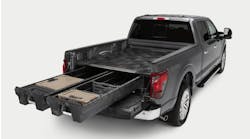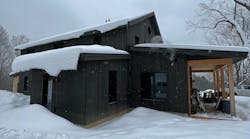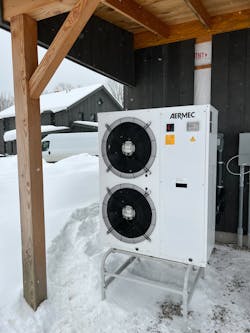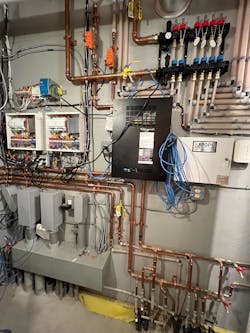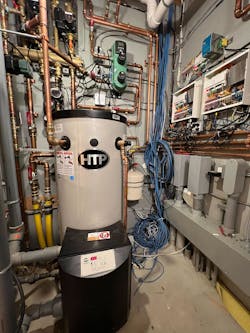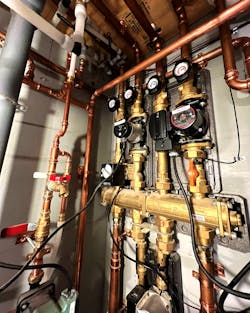Latest from Hydronics & Radiant
Sponsored
“Advances in technology are making homes safer, more efficient, more comfortable and more enjoyable, saving homeowners time and money,” a report from Nasdaq said last year. The Statista report said the smart home market is expected to amount to 93.59 million users by 2027.
One of the primary heating/cooling sources for smart homes are hydronic systems. Like the smart home market, hydronic systems are looking at significant growth. The hydronic underfloor heating market is anticipated to grow at over 6% from 2022-2030, according to Global Market Insights. “The increasing demand for cost-effective heating solutions coupled with government incentives and support for the adoption of underfloor heating solutions will sway the industry landscape,’’ the report said.
Hydronics are already changing the heating landscape in Europe. Changes in the US landscape are under way as well, as demonstrated with the elaborate installation of a hydronic system at a home in New Hampshire. In partnership with Ripcord Engineering, Messana Hydronic Technologies designed the system for a four-bedroom, 3,500 square foot house.
A hydronic system provides heating or cooling by using water as a heat transfer medium, which is pumped through a series of pipes throughout the house. Hydronics pairs well with heat pump technology, which delivers a low carbon footprint, can reduce costs, and can be used for heating and cooling, among other advantages. “We’re seeing more and more air to water heat pumps,’’ said Bryan Rossi of Messana. “Hydronics have a much longer life span and the flexibility to use gas and electrical sources. It’s very normal in Europe, but in the United States there’s a very small amount of hydronics on the market.”
Pump It Up
The New Hampshire home illustrates a trend that is taking root in several pockets of the US, notably New England and some Western states. Hydronics are slowly infiltrating the US market, and those are the regions where hydronics are establishing a foothold.
The home in Jackson, NH includes a barn that serves as a guest house. The system includes 13 zones, a 5-ton heat pump and Messana’s mSense room comfort sensors and controls. They monitor relative humidity, temperature, and Volatile Organic Compounds (VOCs), which is essentially indoor air quality.
A 5-ton Aermec air-to-water heat pump serves as the heart of the hydronic system. It supplies hot and cold water to several radiant floors and Jaga hydronic fan coils.
The home’s first floor utilizes a radiant floor for first stage heating and cooling, and six fan coils for second stage heating and cooling. The second floor uses Jaga Briza 22 fan coils to provide heating and cooling to the upstairs bedrooms, and electric radiant floor for heating the bathrooms. The barn uses a concrete radiant floor for both heating and cooling.
While it seems complex, Rossi said the system is quite simple. Messana designs systems for residential and commercial buildings of all shapes and sizes. The New Hampshire project covered 5,000 square feet, including 1,500 square feet in the adjacent barn.
“It’s a fairly simple system for the most part,’’ Rossi said. “It’s a single tank with radiant floor heat on the first floor. They used 1-inch thick hardwood floors, which is extremely thick. The BTU output in cooling is not super high. The fan coils are designed to supplement those areas, to ramp up and down as needed. The upstairs has no radiant heat. The barn has its own radiant floor for heating and cooling but no supplemental fan coils.”
Perfect Temperature
One of the features in smart home technology is room comfort sensors, which play an important role in maintaining the proper setting for the homeowner.
The mSense device measures the operative temperature by combining the influence of air and radiant temperature in a way similar to a person’s skin receptors.
Sensors also pick up relative humidity and air quality. A gas sensor measures COշ and other substances that directly affect a person’s health.
“People typically respond to thermal discomfort by continually readjusting their thermostat,’’ Rossi said. “An air-based thermostat never represents the real human thermal exchange. mSense comfort sensor is an essential element of a climate control system especially in presence of radiant ceiling panels but also in conventional radiant floor and air systems.”
Many of the smart home systems have apps that allow for remote control of the heating system. That allows for more efficient use of the heating system and saves money for the homeowner.
Ready in Reserve
New Hampshire winters can call for a significant heating load, and the thick flooring can make it harder to get the room to higher temperatures.
Messana also included an HTP Phoenix high-efficiency water heater in the project. The PH130-55 has a Btuh/input range of 35,000-130,000.
“The Phoenix is a backup for the heating side of the house,’’ Rossi said. “When the required buffer tank temperature is not being met, Messana's controls activate the HTP water heater to assist the air-to-water heat pump in reaching the required buffer tank temperature."
The Phoenix has up to a 96 percent thermal efficiency rating, and its modulating burner operates at a 5:1 turndown ratio, which provides high system efficiency even during low load conditions. A laser welded tank constructed with 316L stainless steel resists corrosion and a hybrid cupronickel/stainless steel heat exchanger offers superior heat transfer capabilities and expands and contracts rapidly, eliminating scale build up and promoting self-cleaning.
“It’s going to provide plenty of heat, and we were able to add another stage of heating by adding in a pump block without having to buy a whole other boiler,’’ Rossi said.
Pros and Cons
Efficiency is the primary advantage of hydronics, but there are others as well.
Hydronics reduce allergens, and separate zones allow for individual control of bedrooms and living areas. They also provide ambient heat, which helps maintain comfortable humidity in contrast to forced air systems, which heat air and dry it out.
Hydronics systems are quiet, do not require ducts and require little maintenance while offering durability.
There are however cons as well. The system can take longer to heat up, and potential freezing can damage the system. Installations must be carefully planned and installing a system in an older home can be expensive. If a pipe leaks or bursts, walls or floors will need to be torn up to fix the issue.
Those issues, however, are not stopping the migration to hydronics.
“You’re going to see more and more demand for hydronics,’’ Rossi said. “They have a much longer life span and the flexibility to use gas and electric, or to even use them together. That’s the long-term plan for cooling and heating in the US. Right now, hydronics is such a small market. But it’s very normal in Europe, where a lot of homes already have the infrastructure in place. I think we’re definitely going to see that shift over to the US.”
Thomas Renner writes on building, construction, engineering and other trade industry topics for publications throughout the United States.
